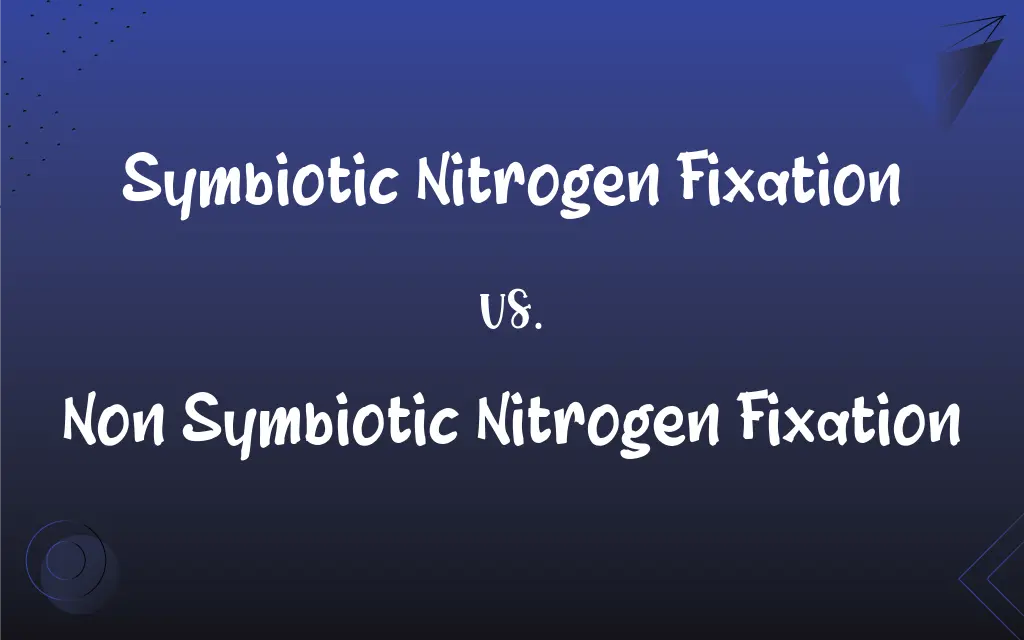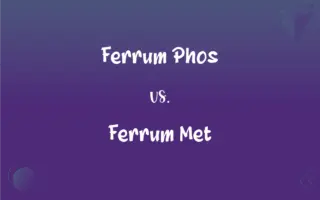Symbiotic Nitrogen Fixation vs. Non Symbiotic Nitrogen Fixation: What's the Difference?
By Janet White || Published on March 5, 2024
Symbiotic nitrogen fixation occurs in a mutual relationship between plants and bacteria, while non-symbiotic nitrogen fixation is carried out independently by free-living bacteria.

Key Differences
Symbiotic nitrogen fixation involves a close partnership between nitrogen-fixing bacteria, such as Rhizobium, and leguminous plants. This process converts atmospheric nitrogen into ammonia, which the plant can use, in exchange for carbohydrates and a protective niche provided by the plant. Non-symbiotic nitrogen fixation, on the other hand, is carried out by free-living bacteria and archaea, such as Azotobacter and Cyanobacteria, that fix nitrogen without the need for a plant host. They convert nitrogen into a form usable by themselves and other organisms in the soil.
In symbiotic nitrogen fixation, the bacteria inhabit plant root nodules, creating a physical and biochemical environment conducive to nitrogen fixation. This environment is oxygen-restricted to facilitate the action of the nitrogenase enzyme, which is oxygen-sensitive. In contrast, non-symbiotic nitrogen-fixing organisms live independently in the soil or water and must adapt to varying environmental conditions, including the presence of oxygen, to fix nitrogen efficiently.
The efficiency of nitrogen fixation differs significantly between the two processes. Symbiotic nitrogen fixation is generally more efficient due to the optimized conditions within the root nodules and the direct transfer of fixed nitrogen to the plant. Non-symbiotic nitrogen fixation is less efficient, as the fixed nitrogen is first released into the environment before it can be utilized by plants, leading to potential losses.
Symbiotic nitrogen fixation plays a crucial role in sustainable agriculture by reducing the need for synthetic nitrogen fertilizers, which can be environmentally harmful. It also contributes to soil health by increasing the available nitrogen content. Non-symbiotic nitrogen fixation contributes to the nitrogen cycle more broadly, enriching soils and aquatic systems but is less directly beneficial to agriculture.
Both symbiotic and non-symbiotic nitrogen fixation are essential for the nitrogen cycle, maintaining the balance of nitrogen in ecosystems. However, their roles, mechanisms, and impacts on agriculture and the environment differ, reflecting the complexity and diversity of nitrogen-fixing processes in nature.
ADVERTISEMENT
Comparison Chart
Interaction
Occurs in a mutual relationship between plants and bacteria
Carried out by free-living bacteria and archaea
Location
Within plant root nodules
In soil or water, independent of plants
Efficiency
Generally more efficient due to optimized conditions
Less efficient, with potential loss of fixed nitrogen
Contribution to Agriculture
Directly benefits leguminous plants and soil health
Indirectly enriches soil nitrogen content
Environmental Impact
Reduces the need for synthetic fertilizers
Supports the nitrogen cycle broadly without direct plant association
ADVERTISEMENT
Symbiotic Nitrogen Fixation and Non Symbiotic Nitrogen Fixation Definitions
Symbiotic Nitrogen Fixation
Requires the formation of root nodules for the process to occur.
The nodules on clover roots are sites of intense symbiotic nitrogen fixation activity.
Non Symbiotic Nitrogen Fixation
Occurs independently of plants, enriching the soil nitrogen pool.
Non-symbiotic nitrogen fixation by Cyanobacteria plays a crucial role in aquatic ecosystems.
Symbiotic Nitrogen Fixation
Involves the direct transfer of nitrogen from bacteria to the host plant.
Soybeans benefit from symbiotic nitrogen fixation, reducing the need for fertilizers.
Non Symbiotic Nitrogen Fixation
Free-living organisms fix nitrogen without forming symbiotic relationships.
The presence of non-symbiotic nitrogen-fixing bacteria in soil supports plant growth.
Symbiotic Nitrogen Fixation
Enhances soil fertility through the biological conversion of atmospheric nitrogen.
Symbiotic nitrogen fixation by alfalfa improves the nitrogen content of agricultural lands.
Non Symbiotic Nitrogen Fixation
Can take place in various environments, including soil and water.
Rice paddies benefit from non-symbiotic nitrogen fixation by aquatic microorganisms.
Symbiotic Nitrogen Fixation
The process where bacteria convert atmospheric nitrogen into ammonia within plant root nodules.
Legumes host Rhizobium bacteria for symbiotic nitrogen fixation to enrich soil nitrogen.
Non Symbiotic Nitrogen Fixation
The conversion of atmospheric nitrogen into usable forms by free-living bacteria.
Azotobacter species contribute to non-symbiotic nitrogen fixation, benefiting crop fields indirectly.
Symbiotic Nitrogen Fixation
A mutualistic relationship between specific bacteria and leguminous plants.
Symbiotic nitrogen fixation in pea plants provides essential nutrients for their growth.
Non Symbiotic Nitrogen Fixation
Supplements the nitrogen cycle, offering a broader ecological impact.
Non-symbiotic nitrogen fixation by soil bacteria enriches nutrient-poor soils.
FAQs
What is symbiotic nitrogen fixation?
It's the process where specific bacteria convert atmospheric nitrogen to ammonia within root nodules of leguminous plants, in a mutualistic relationship.
How does non-symbiotic nitrogen fixation differ from symbiotic?
Non-symbiotic nitrogen fixation is carried out by free-living bacteria and archaea in the soil or water, without a direct relationship with plants.
How do plants form symbiotic relationships with nitrogen-fixing bacteria?
Plants secrete chemicals that attract specific bacteria, leading to the formation of root nodules where nitrogen fixation occurs.
Can non-symbiotic nitrogen-fixing bacteria benefit crops?
Yes, indirectly by enriching the soil nitrogen content, which can then be utilized by crops.
Can non-symbiotic nitrogen fixation occur in aquatic environments?
Yes, certain bacteria and cyanobacteria can fix nitrogen in freshwater and marine ecosystems.
What environmental conditions favor non-symbiotic nitrogen fixation?
Warm, moist conditions generally favor the activity of free-living nitrogen-fixing bacteria.
How is symbiotic nitrogen fixation regulated in plants?
Plants regulate oxygen levels within nodules to ensure the proper function of the nitrogenase enzyme.
What role do symbiotic nitrogen-fixing bacteria play in the nitrogen cycle?
They convert atmospheric nitrogen into a form that is usable by plants, contributing to the cycle of nitrogen through ecosystems.
How do farmers encourage symbiotic nitrogen fixation?
By planting legume crops or using crop rotation practices that include leguminous plants.
Is genetic engineering used to enhance nitrogen fixation?
Research is ongoing to genetically modify plants and bacteria to improve efficiency and expand the range of crops that can fix nitrogen symbiotically.
Are all legumes capable of symbiotic nitrogen fixation?
Most legumes can form these relationships, but the efficiency and specificity can vary among species.
Why is symbiotic nitrogen fixation important for agriculture?
It provides a natural source of nitrogen, reducing the need for synthetic fertilizers and improving soil health.
How does climate change impact nitrogen fixation processes?
Changes in temperature and precipitation patterns can affect the activity and distribution of nitrogen-fixing organisms.
What challenges face non-symbiotic nitrogen fixation in agriculture?
Ensuring that fixed nitrogen benefits crops directly is a challenge due to the indirect nature of the process.
How do legumes benefit from symbiotic nitrogen fixation?
They receive a direct supply of usable nitrogen, which supports their growth and reduces their dependence on soil nitrogen.
Can nitrogen fixation improve reforestation efforts?
Yes, by planting nitrogen-fixing plants, soils can be enriched, supporting the growth of other plant species.
What research is being done on nitrogen fixation?
Studies focus on understanding the mechanisms of both symbiotic and non-symbiotic processes and their potential enhancement for agricultural benefits.
What is the future of nitrogen fixation in sustainable farming?
Enhancing natural nitrogen fixation processes is seen as a key strategy for reducing chemical fertilizer use and promoting environmental sustainability.
Can non-symbiotic nitrogen-fixing bacteria live on plant surfaces?
Yes, some can colonize plant roots or leaves but do not form the intimate symbiotic relationships seen in root nodules.
Are there synthetic ways to fix nitrogen?
The Haber-Bosch process is a synthetic method to fix nitrogen but is energy-intensive; research continues on more sustainable biological methods.
About Author
Written by
Janet WhiteJanet White has been an esteemed writer and blogger for Difference Wiki. Holding a Master's degree in Science and Medical Journalism from the prestigious Boston University, she has consistently demonstrated her expertise and passion for her field. When she's not immersed in her work, Janet relishes her time exercising, delving into a good book, and cherishing moments with friends and family.
































































